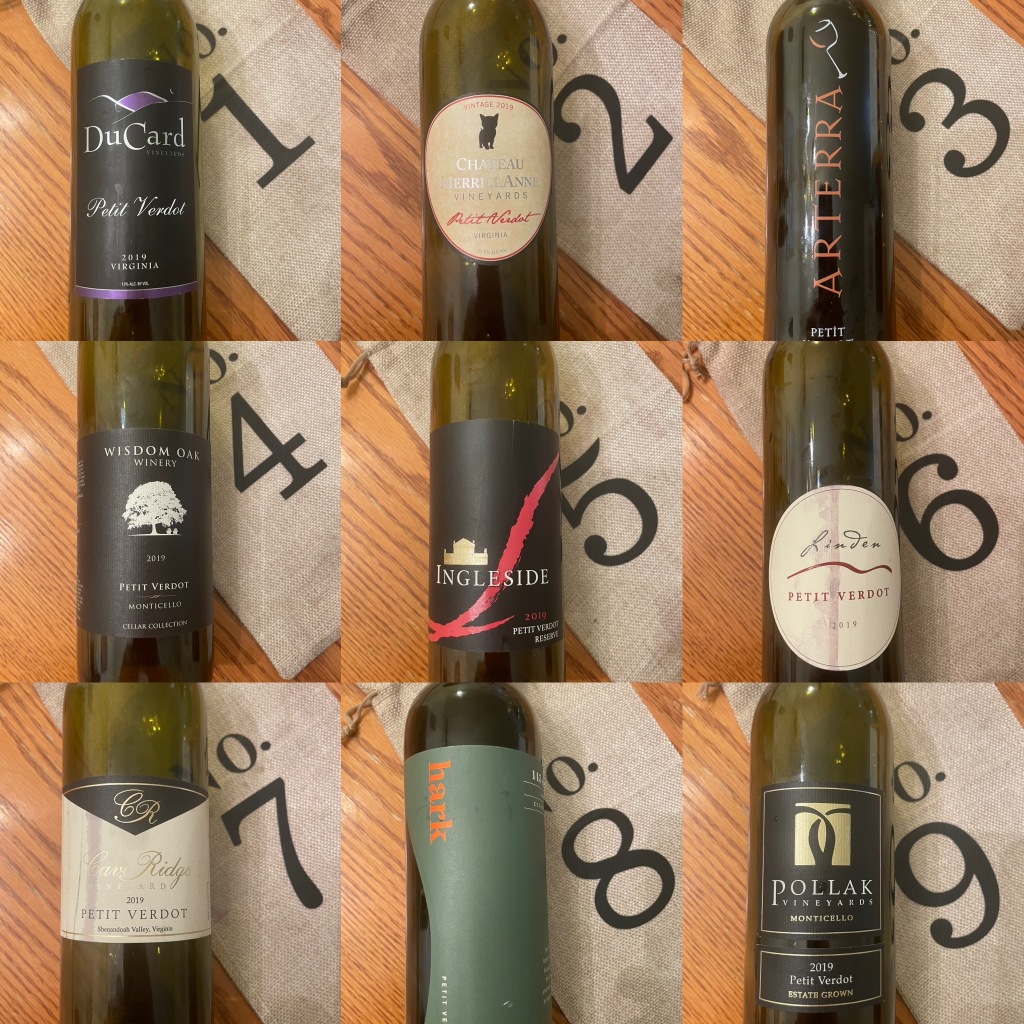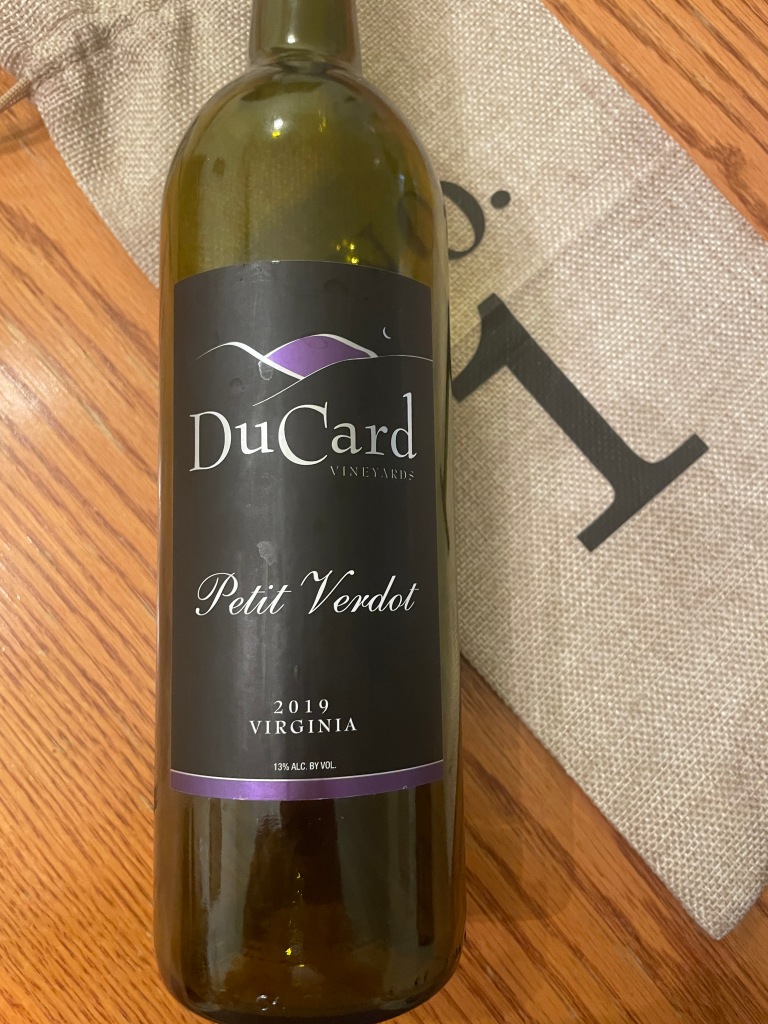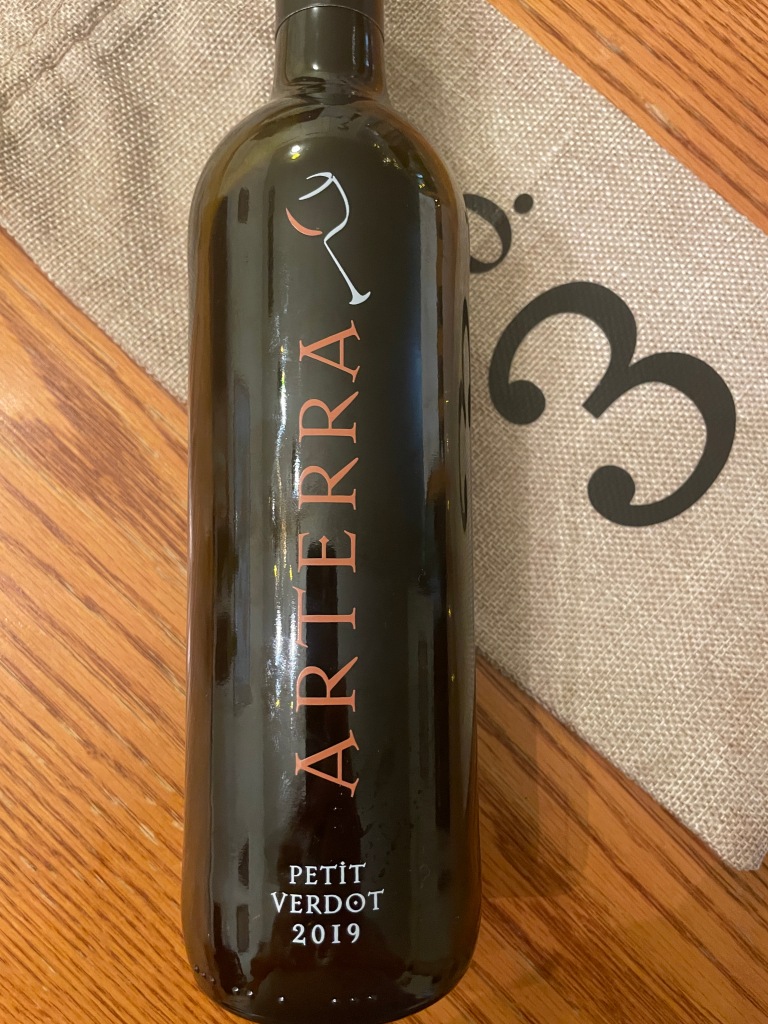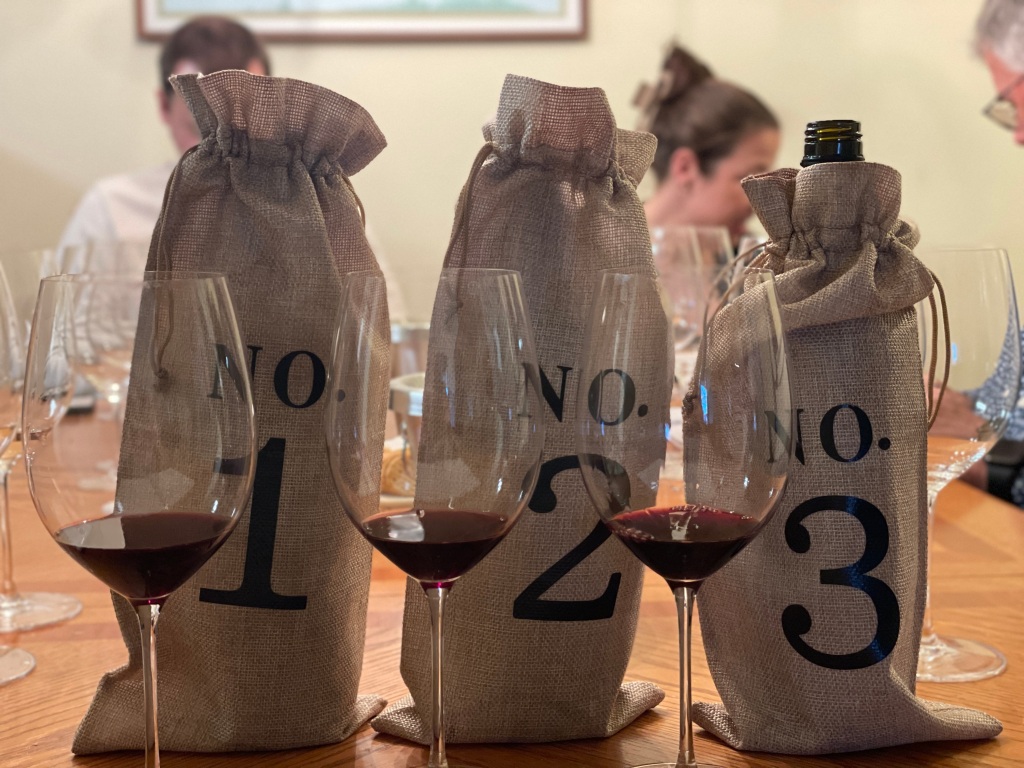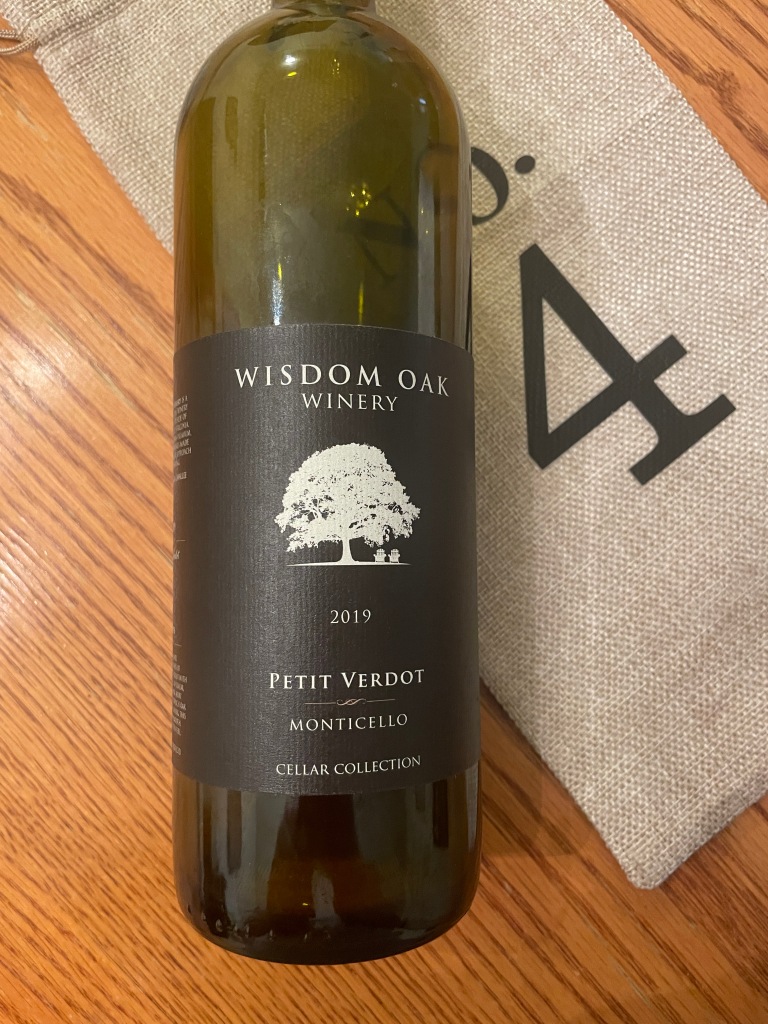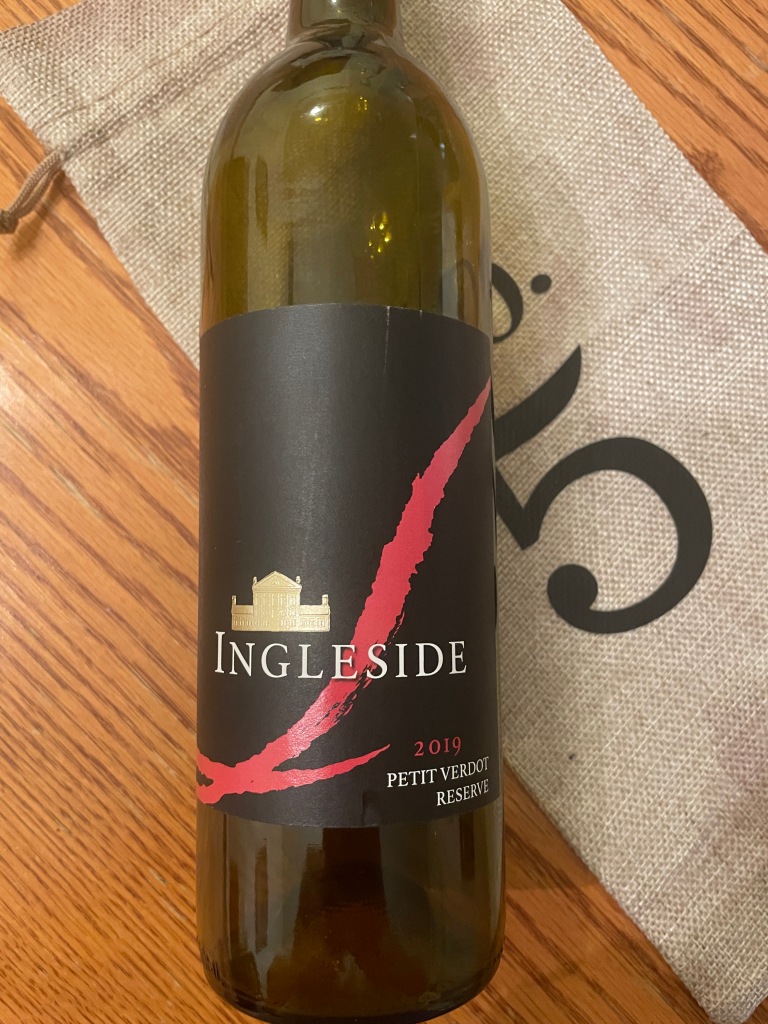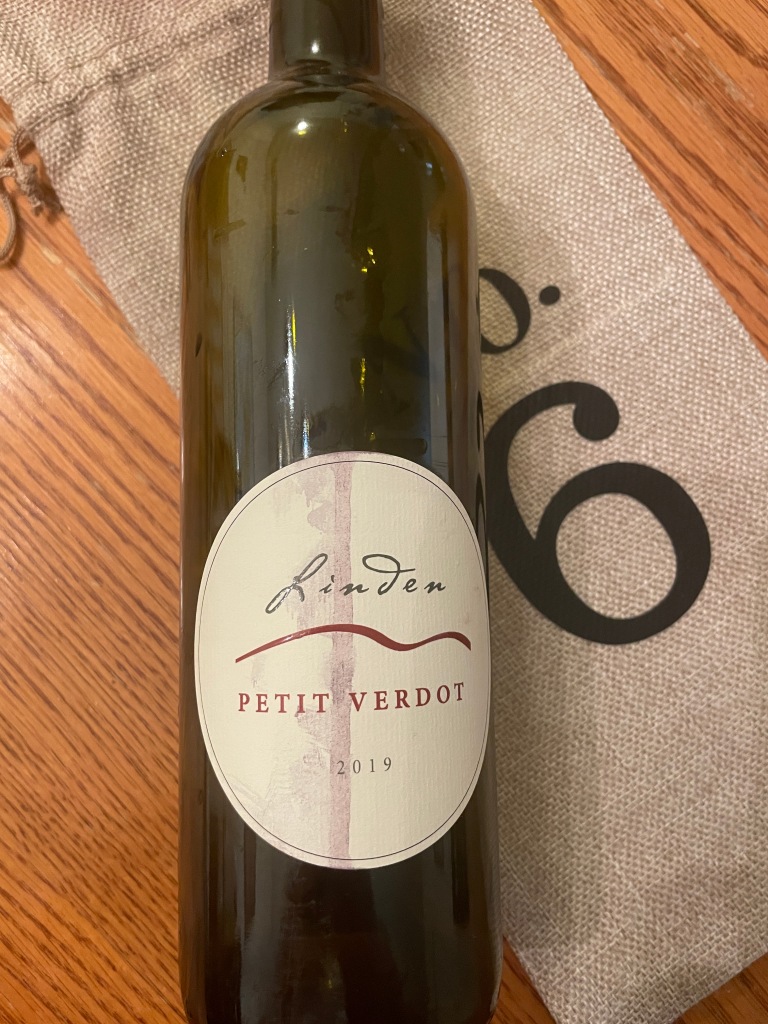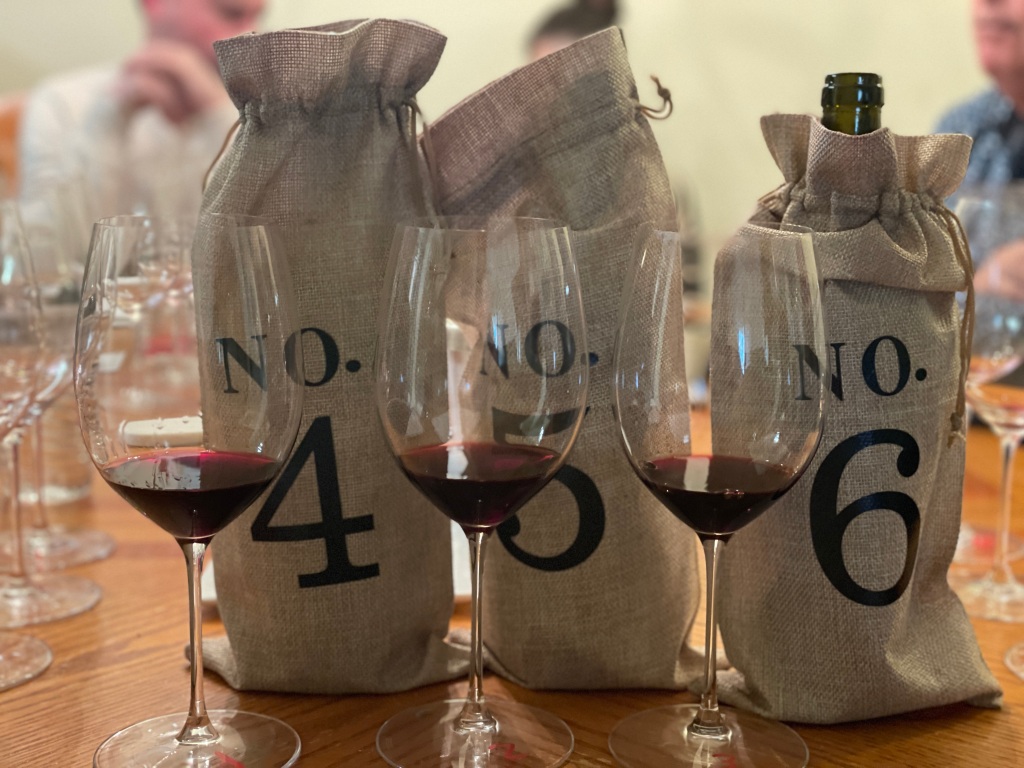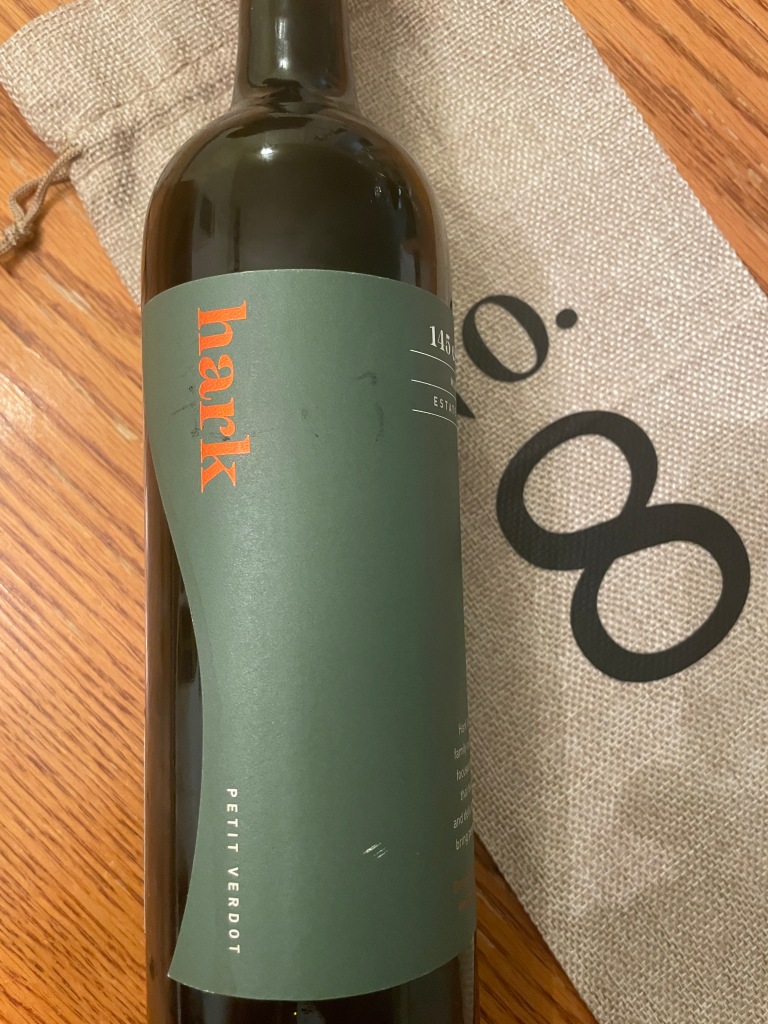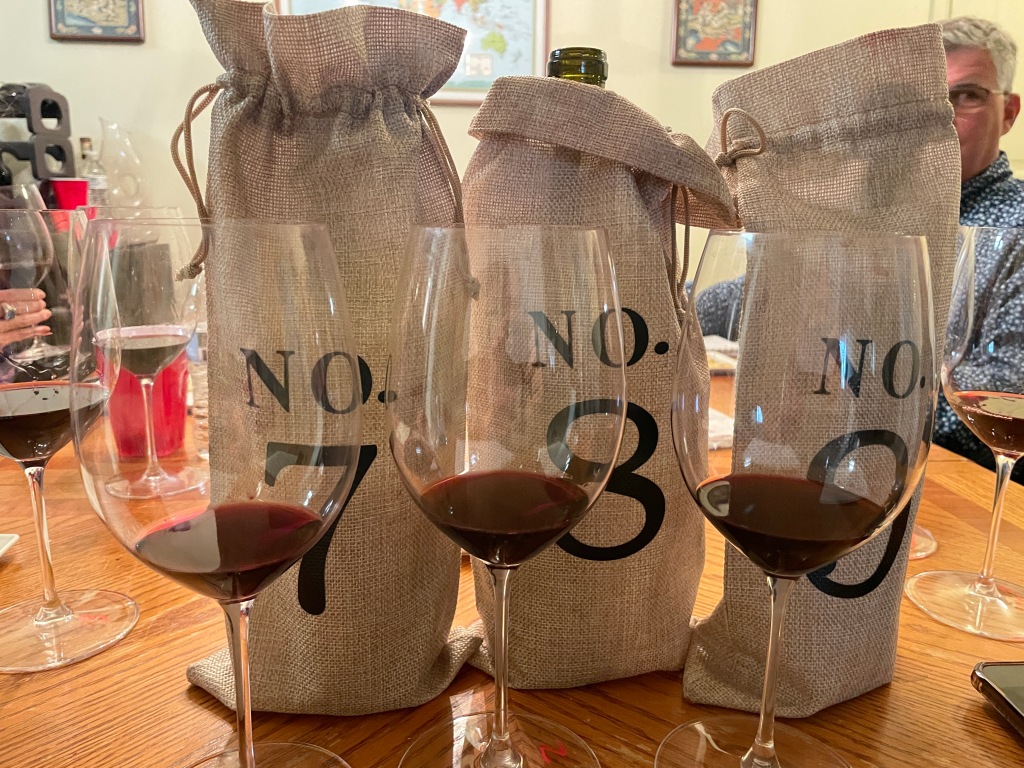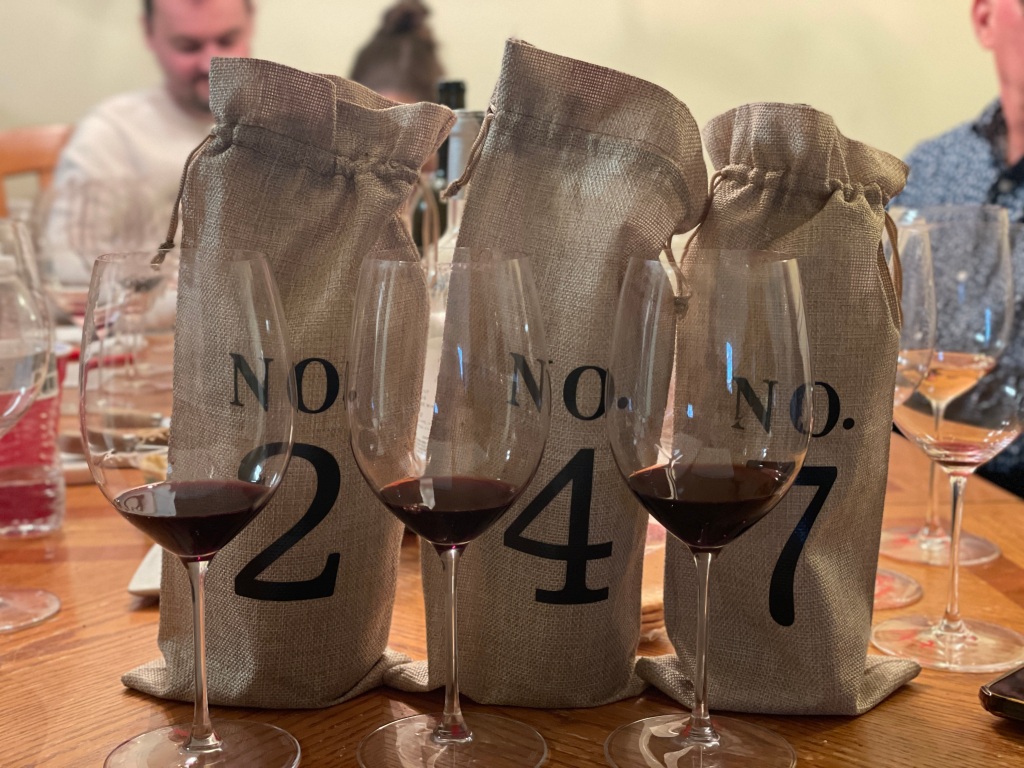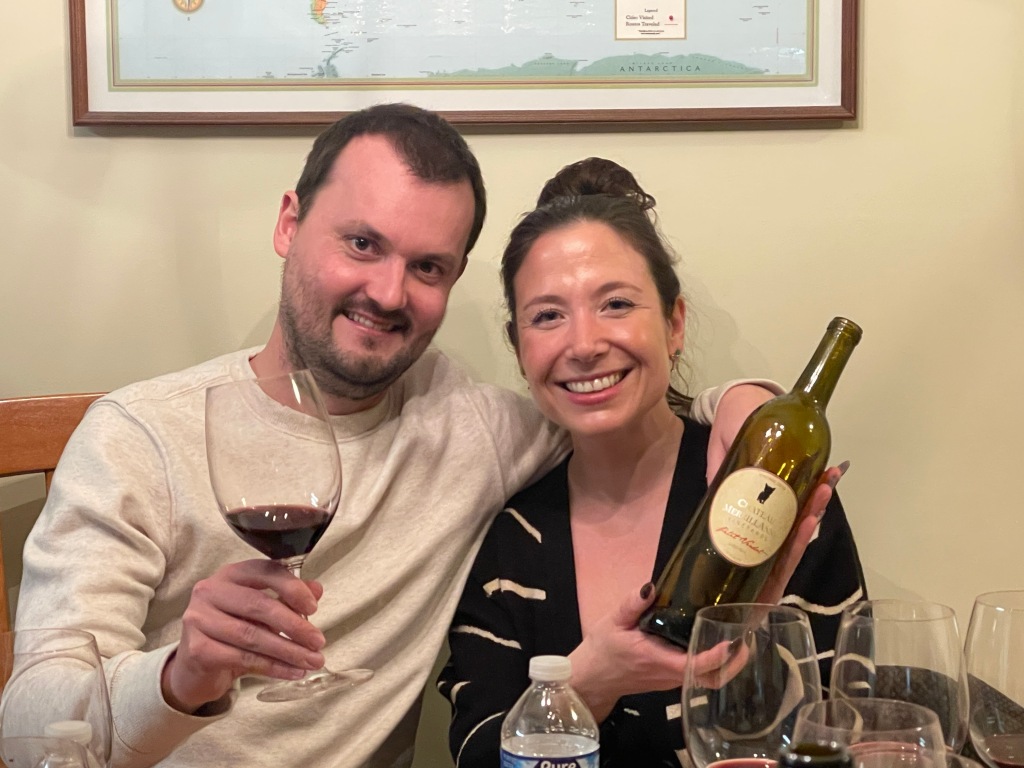This event was three years in the making. Petit Verdot has long been one of my favorite grape varieties, so serving PV in a blind tasting was a no brainer.
But this particular tasting wasn’t any typical event, since it only included the top wines of my three previous Petit Verdot tastings; one only using wine from the 2017 vintage, a second that compared Virginia PVs to other regions, and a third that only tasted the 2019 vintage.
Each of these blind tastings produced three top contenders. I did my best to collect those specific vintages, or at least the closest I could find. Thanks to the generosity of several wineries who opened up their wine libraries, I was able to collect 7 of the 9 of these top-scoring wines.
There were two exceptions. I wasn’t able to get a 2017 Cave Ridge Petit Verdot. But since I had a 2019 Cave Ridge PV, I figured that’s close enough.
Neither was I wasn’t able to get a bottle of a 2018 True Heritage Petit Verdot (used in my second event). But I did get the next best thing; a 2020 Petit Verdot from Southwest Mountains Vineyards, which is actually from the same vineyard (Castalia Farm) and winemaker (Emily Pelton).

Tasting & Scoring Methodology
A group of friends & I blind tasted 9 wines in 3 flights. All the flights were bagged blind.
We didn’t have a sophisticated scoring system. The goal was to pick a ‘favorite’ in every flight, as opposed to rating them and determining which one we thought was the ‘best’.
The favorite of every flight went to a ‘finalist’ round. I took the extra step of hiding the ‘finalists’ with a second bag, so any biases of an earlier tasting hopefully didn’t carry over to the final round.
After finishing the final round, we unveiled all the wines and crowned the overall favorite of the day.
This group was composed of Virginia wine aficionados, so all were very familiar with Petit Verdot.
The contenders:

- 2019 Wisdom Oak Winery
- 2017 Glen Manor Vineyards
- 2017 Arterra Wines
- 2017 Hark Vineyards
- 2020 Southwest Mountains Vineyards
- 2019 Chateau MerrillAnne
- 2019 Cave Ridge Vineyard
- 2017 DuCard Vineyards
- 2014 Linden Vineyards
We also kicked things off with a pet-nat Petit Verdot from Early Mountain Vineyard.
Flight #1:
- Bottle #1: 2019 Wisdom Oak (round winner)
- Bottle #2: 2017 Glen Manor
- Bottle #3: 2017 Arterra Wines



Bottle #1 / 2019 Wisdom Oak. This was the fruitiest wine of the flight (and turned out, of the event). Very nice aroma which reminded us of “sweet cherries and brandy”; at least one person mentioned they found some coconut as well. Notes of stewed strawberry, plumb, and maybe some vanilla on the palate, followed by some barrel notes.
Bottle #2 / 2017 Glen Manor. Soft, aromatic nose, with notes of barnyard and black cherry. Someone mentioned ‘forest floor’ as well. Black plumb or more general ‘dark fruit’ on the palate. A few detected a ‘hot note’ of higher alcohol (which turned out to be true; at 14.7% it was the highest-alcohol wine of the day).
Bottle #3 / 2017 Arterra Wines. Rustic nose. Tart cherry on the palate. Notes of leather. Someone mentioned ‘meaty’ notes, which I would agree with. It was pretty easy to tell this was a natural ferment, since everything just seemed ‘different’. In retrospect I probably should have opened it up much earlier, since wines from Arterra need extra time to open up.
Votes: When it came time to pick a favorite, this was probably the first time I’ve had 100% of my attendees vote the exact same way, for the exact reasons. All seven of us gravitated towards Wine #1/Wisdom Oak very quickly.
That said, I wish I had more time with this round. #2/Glen Manor was just hitting its stride as I took votes, and some guests seemed conflicted if they should stick with their original vote or change it.
Arterra likewise need time to open up, since their wine isn’t designed to be ‘showy’. I had a glass the next day and it definitely smoothed out.
- Alex: 1/2/3. Thought #1 had the best nose and best balance
- Allison: 1/2/3.
- Dave: 1/2/3. Liked #1 from start to finish.
- Kathy: 1/2/3.
- Matt: 1/2/3.
- Stephanie: 1/2/3.
- Vicki: 1/2/3. Liked the fruit-forward nature of the wine.

Flight #2:



- Bottle #4: 2017 Hark Vineyards
- Bottle #5: 2020 Southwest Mountains Vineyards (round winner)
- Bottle #6: 2019 Chateau MerrillAnne
This was probably the most difficult round to pick a favorite as we really, really enjoyed them all. All of these wines were also very aromatic, which was unusual for Petit Verdot.
Bottle #4 / 2017 Hark Vineyards. I was immediately taken by the very plush, almost ‘juicy’ aroma. Others mentioned the nose had notes of purple flower, graphite, forest floor, or grassy. Very dark in color.
The palate had dark fruit and rougher & aggressive tannins. Someone mentioned they found a ‘metallic’ note, but didn’t mean to use that as a negative.
Bottle #5 / 2020 Southwest Mountains Vineyards. Long, juicy finish. Bright, lightly colored, “sweet” nose; it almost reminded me of a Nebbiolo. The palate was on the lighter side, with a sweet barrel note to it.
I later learned this had 20% Merlot, so the softness made a lot of sense.
Bottle #6 / 2019 Chateau MerrillAnne. Soft aromatics; maybe notes of caramel? Not a lot of fruit on the palate; someone mentioned they felt the barrel was overpowering it. My favorite descriptor was ‘cherry cordial”, which several agreed with.
Votes: We gravitated towards SWM Vineyards, but really liked all of these wines. I suspect the softness of the SWM was a huge attraction.
- Alex: 5/6/4.
- Allison: 5/6/4.
- Dave: 5/6/4.
- Kathy: 5/4/6. Voted #5 for the ‘juicy-fruit’ quality of it, but also liked the cherry/tannin combo of #4.
- Matt: 5/4/6.
- Stephanie: 5/6/4. Toss-up between 4 & 6, but liked #5 all the way through, from nose to finish.
- Vicki: 5/6/4. Voted for #5 because of the cherry/vanilla qualities. Thought #4 was too acidic.

Flight #3:
- Bottle #7: 2019 Cave Ridge Vineyard
- Bottle #8: 2017 DuCard Vineyards
- Bottle #9: 2014 Linden Vineyards



This was our tannic, heavier-alcohol, ‘food wine’ round. We started to heavily snack during this round and anything with fattiness greatly improved nearly all of these wines.
It really came down to a narrow finish between #8 and #9.
Bottle #7 / 2019 Cave Ridge Vineyard. Lots of different notes on this one. I found blueberry on the nose (and palate), while others said it was more toasty, maybe toffee.
Descriptors on the palate varied greatly. Some mentioned raspberry/cherry, others mentioned dark chocolate; even bitter chocolate (I suspect those were the tannins talking to me).
Bottle #8 / 2017 DuCard Vineyards: Caramel nose. Palate descriptors ranged from dark chocolate to caramel to sweet fruit. The fruit was most prominent on the finish.
Bottle #9 / 2014 Linden Vineyards: Stewed red berries and tart on the palate, with a sweet cherry finish. The nose wasn’t well received; the higher alcohol was a turn-off (it was actually slightly less alcoholic than other bottles but didn’t wear that alcohol as well).
Many mentioned they wished the nose was as good as the palate, although the nose seemed to lighten up the longer the tasting went on. That helped greatly, which swayed some votes from #8 towards #9. This was actually 88% PV, with 8% Cab Sauv and 4% Carmenere’.
Votes:
- Alex: 8/7/9. The nose of #8 was well integrated, while #7 and #9 had more alcohol.
- Allison: 8/7/9
- Dave: 9/8/7. Thought #9 had a little more complexity than the others.
- Kathy: 9/8/7
- Matt: 9/8/7. Thought #9 opened up enough to put it ahead.
- Stephanie: 9/8/7. Also liked #9 more as it opened up.
- Vicki: 8/7/9. Also agreed with Alex; thought #8 was well integrated.

Finalist Round:

- Bottle #1: 2019 Wisdom Oak Winery (Event Winner)
- Bottle #5: 2020 Southwest Mountains Vineyards
- Bottle #9: 2014 Linden Vineyards (Runner Up)
I didn’t take extensive tasting notes this round. Neither did I bother re-bagging them. These wines were so memorable, a new bag wouldn’t have done anything.
All of us were really struck by the fruitiness of wine #1 (Wisdom Oak). That fruitiness really stood out, especially compared to some of these tannic heavy-hitters.
We loved it so much that when I did the vote tally, 6 out of 7 participants decreed the 2019 Wisdom Oak Petit Verdot was the best wine of the event. It was just really well balanced, with a strong fruit quality that really put it over the top.
I contacted owner/winemaker Jason Lavallee for details on this wine (PS – except for some library bottles, it’s sold out) and he explained his opinion where those fruit notes came from.
According to Jason, the particular barrels he used were actually designed for white wine, specifically for those whites to showcase more fruit qualities. Surprisingly this only got a Silver at the Monticello Cup; maybe it just wasn’t ready yet? Well, it’s ready now!

Votes:
- Alex: 1/5/9
- Allison: 1/5/9
- Dave: 1/5/9
- Kathy: 1/9/5
- Matt: 9/5/1
- Stephanie: 1/9/5
- Vicki: 1/5/9
Lessons Learned:
This was a tough one to judge. I don’t really have any ‘lessons learned’, but do have a few observations. I just wish I knew how to best enact them.
First, many of these wines presented very differently than other bottles of the SAME VINTAGE did even a few months back. I can’t explain why they tasted so differently.
Second, nearly all these bottles could have greatly benefited from decanting. I thought about that in advance and opened them up around noon (we started tasting around 3 PM), even sampling them to ensure more air entered the bottle (you know…quality control…). But that limited amount of air wasn’t nearly enough. I think we would have enjoyed them much more if I had given them a full decanting.
Third, I understand what people say about “Petit Verdot overload”. By that third round my mouth was drying out. I also suspect that it wasn’t a coincidence that the 2 of the 3 top bottles had 12-20% of another grape blended in to smooth the tannic nature of PV down.
I’m undecided if serving food with these wines would have helped. Granted, that would have been unfair since a wine should be judged on its own, not on the quality of the pairing. But this entire event really did cry out for more food. Something to keep in mind in the future.



